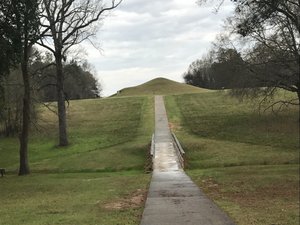Advertisement
Published: March 19th 2017

 IMG_0086
IMG_0086
Approaching the Earthen LodgeOcmulgee National Monument, Macon, Georgia
If Russell Cave was a bit of a disappointment, Ocmulgee definitely was not. Ocmulgee is the name of a river that runs through here, and a thousand years ago the Indians built a very complex settlement. They were part of a civilization known as Mississippian, scattered through the south, but concentrated along tributaries of the Mississippi River as far north as Iowa, Illinois, and Ohio. They built huge earthen mounds, as large as football fields and as tall as fifty feet. Mostly, these mounds served as platforms, possibly as locations for other grand structures, such as temples or the homes of the elite.
One of these mounds, the funeral mound here at Ocmulgee, served as a cemetery. It has been a rich source of artifacts for archeologists. In addition to the bones of the buried, arranged frequently in a seated position (??), they have found collections of artifacts that indicate a trade with other cultures, including sea shells, and copper items probably from as far away as Minnesota. There are also beads and other signs of ornamentation, many reflecting some of the same patterns as found in Mayan and Aztec cultures. Could they have

 IMG_0095
IMG_0095
Great Temple Moundbeen trading with Chacoans from the desert southwest? Other artifacts include smoking pipes, rattles, and game implements.
Another key structure for this culture was the Earthlodge. Although, in this reconstruction, the walls and roof have been rebuilt with modern materials, the earthen clay floor is all original and dates back about a thousand years. But I found the characteristics of this structure remarkable because of the similarities to great kivas found in Ancient Puebloan cultures. In the first place, the lodge is built inside an earthen mound. Kivas were built down into the ground. Perhaps the clay earth around here is more difficult to dig into than the sandy soils of New Mexico. So instead of going down, the piled loose dirt up. In both cases, though, the effect is a room surrounded by dirt.
The roof of this earthen lodge is a thatched construction built on a network of crisscrossing poles, supported by four massive wooden posts. So are southwestern kivas. The diameter of the earthen lodge is 42 feet and is built as a nearly perfect circle. Kivas are circles and the great kiva at Chaco is about 46 feet in diameter. The outside circle is

 IMG_0089
IMG_0089
Earthen Lodge Floorrimmed by 50 seats, where the Ocmulgee citizens sat, same as at Chaco. Exactly opposite the entryway is a raised clay platform where, it is believed, the senior chiefs sat; same as at Chaco.
The four posts are perfectly aligned with the cardinal directions, and the entryway allows the sun, at sunrise, to enter and shine on the raised platform exactly on two days of the year - once in February and once in October. These dates are midpoints between the winter solstice and the two equinoxes, both dates that would have significant meaning to agrarian societies as February would be the time to get started on planning and planting crops, and October would be when harvesting should be completed. This calendar would indicate a concern for the yearly cycle that is extremely consistent with what the Ancient Puebloans did in arranging their buildings according to all kinds of solar and lunar events. Although the Ocmulgee didn't seem to take it to the same degree that the southwestern Indians did, the concern for the solar year is definitely shared.
After our Tour of the Ancients trip last year, I had a profound respect for what the Ancient Puebloans

 IMG_0091
IMG_0091
Trenchesaccomplished and was very proud to share a common homeland. But what I am learning now is that they were not alone. It seems that the Mississippian culture here in the east also reached very high levels of development. That they did not build permanent buildings such as the Chacoan Great Houses, is probably an accident of location, not of ability or accomplishment. In central Georgia, there is a lot more dirt than rocks. So it is going to be an advantage to learn to build things out of dirt than to struggle to locate more durable materials. Furthermore, there is a lot more water here than out west which means that erosional forces are going to be greater - things decay and wash away here faster than they do in the desert.
There is so much more to see and learn here at Ocmulgee. Like at Russell Cave, artifacts have been found suggesting occupation of this area for maybe 17,000 years, more or less continuously. (Chaco finds don't go back that far). So the story to be told here is a much longer one. Clovis points have been found indicating the hunting of large ice-age mammals. And then

 IMG_0096
IMG_0096
Lesser Temple Moundthe history moves forward through the Archaic and Woodland phases. And it extends up and through the European invasion, the Trail of Tears as the Creek (today's descendants) were relocated to Oklahoma, the civil war battles, and the damage done in the haste to build a railroad.
This is a very rich site. Unless you are a student of history, especially the deep history of our Indian predecessors, this is probably not a destination site. But if you are in Georgia, you should make an effort to visit. 4 Stars. (17.1.11)
Advertisement
Tot: 0.067s; Tpl: 0.012s; cc: 11; qc: 34; dbt: 0.0359s; 1; m:domysql w:travelblog (10.17.0.13); sld: 1;
; mem: 1.1mb














